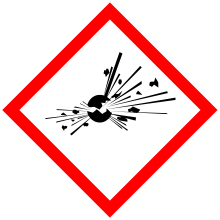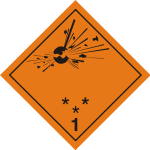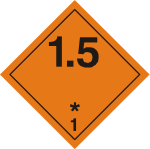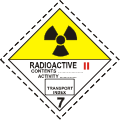GHS hazard pictograms
Hazard pictograms form part of the international Globally Harmonized System of Classification and Labelling of Chemicals (GHS). Two sets of pictograms are included within the GHS: one for the labelling of containers and for workplace hazard warnings, and a second for use during the transport of dangerous goods. Either one or the other is chosen, depending on the target audience, but the two are not used together.[1] The two sets of pictograms use the same symbols for the same hazards, although certain symbols are not required for transport pictograms. Transport pictograms come in wider variety of colors and may contain additional information such as a subcategory number.
Hazard pictograms are one of the key elements for the labelling of containers under the GHS, along with:[2]
- an identification of the product;
- a signal word – either Danger or Warning – where necessary
- hazard statements, indicating the nature and degree of the risks posed by the product
- precautionary statements, indicating how the product should be handled to minimize risks to the user (as well as to other people and the general environment)
- the identity of the supplier (who might be a manufacturer or importer)
The GHS chemical hazard pictograms are intended to provide the basis for or to replace national systems of hazard pictograms. It has still be implemented by the European Union (CLP regulation) in 2009.
The GHS transport pictograms are the same as those recommended in the UN Recommendations on the Transport of Dangerous Goods, widely implemented in national regulations such as the U.S. Federal Hazardous Materials Transportation Act (49 U.S.C. 5101–5128) and D.O.T. regulations at 49 C.F.R. 100–185.
Physical hazards pictograms
 |
Usage | |
|---|---|---|
Further information: Explosive material | ||
| Explosive | ||
 |
Usage | |
|---|---|---|
Further information: Flammability | ||
| Flammable | ||
 |
Usage | |
|---|---|---|
Further information: Oxidizing agent | ||
| Oxidizing | ||
 |
Usage | |
|---|---|---|
| ||
| Compressed Gas | ||
 |
Usage | |
|---|---|---|
Further information: Corrosive substance | ||
| Corrosive | ||
| Usage | ||
|---|---|---|
| ||
| no pictogram required | ||
Health hazards pictograms
 |
Usage | |
|---|---|---|
| ||
| Toxic | ||
 |
Usage | |
|---|---|---|
| ||
| Harmful | ||
 |
Usage | |
|---|---|---|
| ||
| Health Hazard | ||
| Usage | ||
|---|---|---|
| ||
| no pictogram required | ||
Physical And Health Hazard Pictograms
 |
Usage | |
|---|---|---|
| ||
| Corrosive | ||
Environmental hazards pictograms
 |
Usage | |
|---|---|---|
| ||
| Environmental Hazard | ||
| Usage | ||
|---|---|---|
| ||
| no pictogram required | ||
Transport pictograms
Class 1: Explosives
 |
Usage | |
|---|---|---|
The asterisks are replaced by the class number and compatibility code | ||
| Divisions 1.1–1.3 | ||
 |
Usage | |
|---|---|---|
Substances and articles which are classified as explosives but which present no significant hazard
The asterisk is replaced by the compatibility code | ||
| Division 1.4 | ||
 |
Usage | |
|---|---|---|
Very insensitive substances which have a mass explosion hazard
The asterisk is replaced by the compatibility code | ||
| Division 1.5 | ||
 |
Usage | |
|---|---|---|
No hazard statement
The asterisk is replaced by the compatibility code | ||
| Division 1.6 | ||
Class 2: Gases
 |
Usage | |
|---|---|---|
Gases which at 20 °C and a standard pressure of 101.3 kPa:
| ||
| Division 2.1 | ||
 |
Usage | |
|---|---|---|
Gases which:
| ||
| Division 2.2 | ||
 |
Usage | |
|---|---|---|
Gases which:
| ||
| Division 2.3 | ||
Classes 3 and 4: Flammable liquids and solids
 |
Usage | |
|---|---|---|
Liquids which have a flash point of less than 60 °C and which are capable of sustaining combustion
| ||
| Class 3 | ||
 |
Usage | |
|---|---|---|
Solids which, under conditions encountered in transport, are readily combustible or may cause or contribute to fire through friction; self-reactive substances which are liable to undergo a strongly exothermic reaction; solid desensitized explosives which may explode if not diluted sufficiently | ||
| Division 4.1 | ||
 |
Usage | |
|---|---|---|
Substances which are liable to spontaneous heating under normal conditions encountered in transport, or to heating up in contact with air, and being then liable to catch fire | ||
| Division 4.2 | ||
 |
Usage | |
|---|---|---|
Substances which, by interaction with water, are liable to become spontaneously flammable or to give off flammable gases in dangerous quantities
| ||
| Division 4.3 | ||
Other GHS transport classes
 |
Usage | |
|---|---|---|
Substances which, while in themselves not necessarily combustible, may, generally by yielding oxygen, cause, or contribute to, the combustion of other material | ||
| Division 5.1 | ||
.svg.png) |
Usage | |
|---|---|---|
Organic substances which contain the bivalent –O–O– structure and may be considered derivatives of hydrogen peroxide, where one or both of the hydrogen atoms have been replaced by organic radicals
| ||
| Division 5.2 | ||
| Usage | ||
|---|---|---|
Substances with an LD50 value ≤ 300 mg/kg (oral) or ≤ 1000 mg/kg (dermal) or an LC50 value ≤ 4000 ml/m3 (inhalation of dusts or mists) | ||
| Division 6.1 | ||
 |
Usage | |
|---|---|---|
Substances which:
| ||
| Class 8 | ||
Non-GHS transport pictograms
The following pictograms are included in the UN Model Regulations but have not been incorporated into the GHS because of the nature of the hazards.
 |
 |
 |
 |
 |
 |
| Class 6.2 | Class 7 | Class 9 | |||
|---|---|---|---|---|---|
| Infectious substances | Radioactive material | Miscellaneous dangerous substances and articles | |||
Notes
References
- Globally Harmonized System of Classification and Labelling of Chemicals (Second revised ed.), New York and Geneva: United Nations, 2007, ISBN 978-92-1-116957-7, ST/SG/AC.10/30/Rev.2 ("GHS Rev.2")
- "Regulation (EC) No 1272/2008 of the European Parliament and of the Council of 16 December 2008 on classification, labelling and packaging of substances and mixtures, amending and repealing Directives 67/548/EEC and 1999/45/EC, and amending Regulation (EC) No 1907/2006", OJCE (L353): 1–1355, 2008-12-31 (the "CLP Regulation")
- UN Recommendations on the Transport of Dangerous Goods. Model Regulations (Fifteenth ed.), New York and Geneva: United Nations, 2007, ISBN 978-92-1-139120-6, ST/SG/AC.10/1/Rev.15 ("UN Model Regulations Rev.15")
- UN Recommendations on the Transport of Dangerous Goods. Manual of Tests and Criteria (Fourth revised ed.), New York and Geneva: United Nations, 2002, ISBN 92-1-139087-7, ST/SG/AC.10/11/Rev.4 ("UN Manual of Tests and Criteria Rev.4")
External links
| Wikimedia Commons has media related to GHS pictograms. |
- GHS pictogram gallery from the United Nations Economic Commission for Europe
.svg.png)
.svg.png)
.svg.png)
.svg.png)
.svg.png)